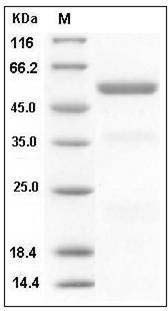-
Product Name
Human Carboxypeptidase E/CPE (His Tag) recombinant protein
- Documents
-
Description
Human carboxypeptidase E (CPE), also known as Carboxypeptidase H, is a peripheral membrane protein and a zinc metallocarboxypeptidase, and the conversion of proCPE into CPE occurs primarily in secretory vesicles. The active form of CPE cleaves C-terminal amino acid residues of the peptide, and is thus involved in the biosynthesis of peptide hormones and neurotransmitters including insulin, enkephalin, etc. The enzymatic activity is enhanced by millimolar concentrations of Co2+. It has also been proposed that membrane-associated carboxypeptidase E acts as a sorting receptor for targeting regulated secretory proteins which are mostly prohormones and neuropeptides in the trans-Golgi network of the pituitary and in secretory granules into the secretory pathway.Its interaction with glycosphingolipid-cholesterol rafts at the TGN facilitates the targeting. Mutations in this gene are implicated in type I I diabetes due to impaired glucose clearance and insulin resistance.
-
Protein name
Carboxypeptidase E
-
Protein short names
R74677; MGC7101; CPH1; CARBOXYPEPTIDASE E; CPH-1; CPH; CPE; FAT
-
Uniprot ID
P16870
-
Gene Name
CPE
-
Source/Expression Host
Human Cells
-
Expression Plasmid/cDNA
A DNA sequence encoding the human carboxypeptidase E (CPE) precursor (NP_001864.1) (Met 1-Ser 453) was fused with a polyhistidine tag at the C-terminus.
-
Protein Species
Human
-
Molecular weight
The recombinant human CPE comprises 439 amino acids and predicts a molecular mass of 49.4 kDa. As a result of glycosylation, the apparent molecular mass of rhCPE is approximately 53 kDa in SDS-PAGE under reducing conditions.
-
Purity
> 90 % as determined by SDS-PAGE
-
Activity
Measured by its ability to cleave a peptide substrate, benzoyl-AR-OH. The product, Arg, is reacted with orthophthaldialdehyde (OPA) to form a fluorescent molecule. The specific activity is >12,000 pmoles/min/μg.
-
Validations

Human Carboxypeptidase E / CPE Protein (His Tag) SDS-PAGE
Related Products / Services
Please note: All products are "FOR RESEARCH USE ONLY AND ARE NOT INTENDED FOR DIAGNOSTIC OR THERAPEUTIC USE"
